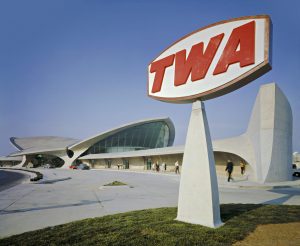Why is this building significant?
Saarinen’s curvaceous, concrete structure is a symbol of post-World War II American optimism and a pioneering manifestation of 1960s experimentalism and exuberance. Inside, beneath swooping vaults, there are curving stairways, a sculptural departure board, and a recessed conversation pit with built-in sofas. Following the Flight Center’s closure in 2001, efforts to preserve the existing building and find a new use for it were launched. Many of the Flight Center’s original details were replaced with replicas of the originals. Two buildings, housing more than 500 hotel rooms, now encircle Saarinen’s original structure. Overall, the complex houses a conference space, restaurants, an aviation history museum, a rooftop swimming pool, and an observation deck. There is also a preserved Lockheed L-1649 Starliner with a new cocktail lounge inside.
What did the New York Landmarks Conservancy do?
The Port Authority, which owns the building, consulted with us after the Flight Center no longer worked as a terminal. We urged them to find a new use and participated in a lengthy federal review. We also helped convince the Port Authority to invest in initial restoration to help attract an investor.
Contemporary









